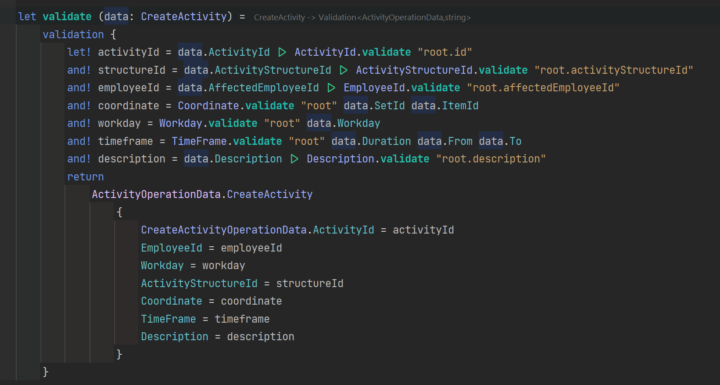
Today’s random F# code from our app is about validating data passed to us over our public API:
Example code showing the usage of FsToolkit.ErrorHandling’s validation computation expression.

C# indeed gets more and more features known to F#, like pattern matching, switch expressions, records, a way to deal with nulls, and someday maybe even discriminate unions and deep equality on collections. Maybe even type inference could become as powerful as in F#. However, C# can’t eliminate the features it already has, like mutability by default and statements. Immutability by default and expressions-only are strengths of F# and make building error-free apps easier. Real pipes and...

On our journey from C# to F#, we were at a point where we changed our (unit) testing strategy. Our approach just didn’t feel right anymore. We struggled to do TDD because we didn’t get the tests to fail first. We wrote tests that didn’t increase our confidence and started thinking of them as waste.
This post is part of the F# Advent Calendar 2021
Thanks to Sergey Tihon for organising the Advent Calendar.

Unquote is a great library for writing test assertions in F#. In our acceptance tests, we frequently check data structures for equality. When these data structures get bigger, reading test failure messages gets harder. That’s why I implemented an F# data structure differ around Unquote that lets me quickly see the differences.

This is part 7 of how we generate types from our .Net backend to be used in our TypeScript client. Why do we even bother?Generating TypeScript constants from .Net constantsFinding the types used in communication between the .Net backend and the TypeScript clientGenerating TypeScript classes from .Net typesGenerating Angular Services from .Net WebApi ControllersTypeScript-friendly JSON serialization of F# typesTesting JSON serialization and deserializationPutting all the parts together In the...

In our F# code, we have a lot of asynchronicity: query the DB, call external services, write messages to the service bus, etc. Inside of our happy F# bubble we use async workflows, either by using Async or by using the computation expression async { ... }. But we are surrounded by a world of Tasks. So we often need to call functions or methods that return a Task. Of course, that is no big problem, we can just add |> Async.AwaitTask, but that leads to a lot of visual clutter in our precious...

There are many libraries for JSON serialization in the .Net realm. The best known are probably Newtonsoft’s Json.NET and System.Text.Json. Both can’t handle F# discriminated unions very well. There are also a couple of F# JSON libraries available like Thoth.Json or FSharp.Json. They are all great libraries, and choosing one is about making trade-offs. However, our case is a bit complicated because we have a mix of C# and F# code. This results in object/value graphs that consist of a...

This is part 6 of how we generate types from our .Net backend to be used in our TypeScript client. Why do we even bother?Generating TypeScript constants from .Net constantsFinding the types used in communication between the .Net backend and the TypeScript clientGenerating TypeScript classes from .Net typesGenerating Angular Services from .Net WebApi ControllersTypeScript-friendly JSON serialization of F# typesTesting JSON serialization and deserializationPutting all the parts together None of...

This is part 5 of how we generate types from our .Net backend to be used in our TypeScript client. Why do we even bother?Generating TypeScript constants from .Net constantsFinding the types used in communication between the .Net backend and the TypeScript clientGenerating TypeScript classes from .Net typesGenerating Angular Services from .Net WebApi ControllersTypeScript-friendly JSON serialization of F# typesTesting JSON serialization and deserializationPutting all the parts together...